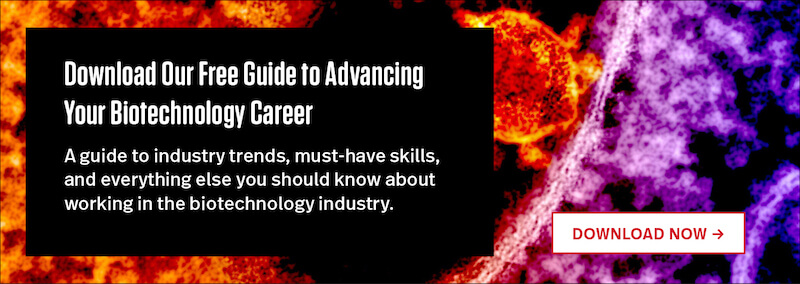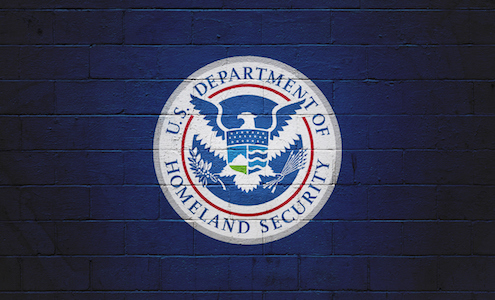One of the core goals of the biotechnology industry is to create products that can positively impact living organisms in need, whether that be a plant, animal, or human. To effectively accomplish this, biotechnicians need to not only develop these products but test them and get them properly approved so they can be safely released to the public.
The “Research and Development (R&D) process” ultimately achieves product approval. It is based on the scientific method and is by design a rigorous process, often involving a series of significant stakeholder analyses and regulatory reviews to ensure a product is properly vetted and ready for use.
As scientists are involved in all aspects of such research, below we explore how a master’s degree can enhance a scientist’s understanding of what it takes to develop and prepare such products for commercial use for patients. We will also review one of the most topical R&D processes of late—the authorizations for use of certain COVID-19 vaccines.
The Product Approval Process in Medical Biotech
After an unmet need is known and a potential biologic or biological drug—which is a medical product derived from a living source—has been discovered in the lab to address that unmet need, scientists work with multiple internal and external stakeholders to research and test the product through clinical trials.
According to the U.S. National Library of Medicine, a clinical trial is a study in which “participants receive specific interventions according to the research plan or protocol created by the investigators.” There are usually three phases, iterative in nature, where the research proves safety (no unexpected harm, inclusive of dosing ranges), efficacy (the product does what it claims to do, inclusive of dosing ranges), and stability as the scale and scope of each trial gets bigger and bigger.
In the case of a biotech product approval, many times the scientists who discovered the science behind the biologic lead the earliest stages of research. However, once there is approval to research with humans (after being deemed safe based on data to do so), and an Investigational New Drug application is accepted by the Federal Drug Administration (FDA), the actual clinical trial becomes a very large program and could be led by a different leader in biotech who has specific experience with clinical trial operations.
The FDA’s Center for Drug Evaluation (which focuses on pharmaceuticals including “pills,” though that’s not the only type of produce under CDER’s oversight) and the FDA’s Center for Biologics Evaluation (which focuses on biologics), aims to review and then approve products that reach the right patient for the right reasons at the right time. They review data from rigorous scientific research methods, seeking to determine whether the benefits outweigh the risks. Specifically, the FDA explains that it is this group’s responsibility to “evaluate new drugs before they can be sold” to prevent fake or harmful medications from surfacing and ensure doctors and patients follow proper dosages and guidelines when using certain drugs.
According to Christa Dhimo—Professor of the Practice for Northeastern’s Master of Science in Biotechnology program and Master of Science in Bioinformatics program—later stage clinical trials are designed to “mimic the real world to whatever extent possible” to ensure that a product will be successful once it’s actually out on the market.
Download Our Free Guide to Advancing Your Biotechnology Career
Learn how to transform your career in an industry that’s transforming the world.
What’s more, throughout a trial, research scientists will gather data regarding how people react to the product then chart the reactions to ensure the expected outcomes, or “endpoints.” While scientists “collect and go through the data, they also feedback such observations to the science so that the science can continue to evolve,” Dhimo says.
By the time a product is ready for final submission and FDA data review in a New Drug Application and Biologics License Application, many years have gone by with an extraordinary effort from scientists.
“When you’re approved, you’re approved to market your product and sell it for patient use, typically to physicians and hospitals,” Dhimo says. “In these cases, you’ve proven…you’re within your expected safety profile and efficacy, and your product has produced enough data that your predictive analysis can correctly say this is what’s likely to happen with the particular patients involved.”
Product Approval vs. Emergency Use Authorization: The COVID-19 Vaccine
In a discussion of product approval in biotech, it’s also important to explore Emergency Use Authorization (EMAs)—a topic explored at great length during the COVID-19 pandemic.
Authorizations for COVID-19 vaccines in early 2021 came with some public concern about whether the authorization was rushed.
“People were worried that they didn’t test enough people [during clinical trials], which wasn’t the case,” Dhimo recalls. “It’s not just about time; think about it more about the strength of data, and this is where your “n”—or your sample population—really matters. These trials included 30K+ and 40K+ patients. That’s about the size of all global employees at Fidelity Investments, and it’s a lot of people. That’s what you want, to encompass as many potential patients as possible within the scope of your trial controls. But there was so much misinformation out there, a large population became worried more about timeline than scope. No one can refute the significance of each trial’s scope for these products. Now we’re in the multiple millions, and that’s significant.”
It’s important to also note that, unlike typical product approvals, emergency use authorizations occur during a state of emergency, and require weighing benefits against risks under the specific lens of how it all relates to the world’s population. This doesn’t just involve the FDA but also the US Department of Homeland Security.
According to the FDA, “under an EUA, [the FDA] may allow the use of unapproved medical products, or unapproved uses of approved medical products in an emergency to diagnose, treat, or prevent serious or life-threatening diseases or conditions when certain statutory criteria have been met, including that there are no adequate, approved, and available alternatives.”
Once it’s been determined that an EUA is necessary, the scientists work to create the required clinical trials and other testing as needed under the FDA requirements.
“What I want to make sure people understand is that emergency use authorizations are exception-only situations that occur under very unusual and high-threat circumstances,” Dhimo explains.
Ultimately, the COVID-19 pandemic fell under these very specific guidelines. With the country in an official state of emergency, the vaccines underwent this intensive approach to approval, which still involved vigorous testing despite its expedited timeline. “They are still very rigorous in terms of the data that you have to provide to be authorized under these circumstances,” Dhimo says.
Much like with product approval, “an authorization says that there’s enough data for regulators to feel that the benefits outweigh the risk based on the data they’ve seen,” she continues. “Now that data is typically based on predicted data, but it’s still backed by science and facts and everything else that approval is based on under normal circumstances.”
For Example: The Pfizer-BioNTech COVID-19 vaccine was tested in a three-phase, randomized, double-blind, and placebo-controlled trial. During this trial, approximately 44,000 participants received the vaccine, according to official documentation from the FDA. The organization gathered safety and efficacy data on these participants, and an analysis of this data showed there was a 95 percent success rate among participants after their second dose. It wasn’t until this time that the vaccine began to be released to the general public for use.
Despite the necessity of an emergency use authorization in cases like the COVID-19 pandemic, Dhimo emphasizes that it’s important for the public to continue to work to understand these core differences between authorization and approval.
Preparing to Work in Product Approval in Biotech
A master’s degree in biotechnology can provide the training and real-world exposure to the product approval process that scientists need to excel in the biotechnology field.
“We have a lot of courses about product approval because we’re expecting our scientists to prepare to enter the professional environment as soon as they graduate,” Dhimo says.
Students in Northeastern’s program accomplish this through a rare combination of academic rigor and real-world experiences. First, they have the opportunity to hone the “power skills they need to be effective in a professional environment” throughout their foundational courses, Dhimo explains. Then they get the chance to apply those skills hands-on within functional biotechnology organizations and labs during their graduate co-op.
“On co-op, they’re either working on pipeline products or in an environment where they’re supporting products that are already in the commercial realm and have had market approval,” Dhimo says. She emphasizes that either type of exposure will give them the chance to learn the intricacies of product approval.
This niche aspect of biotechnology isn’t the only topic covered in Northeastern’s extensive program, however. With dozens of foundational and elective courses and eleven tailored concentrations to choose from, professionals graduate with not only a firm understanding of the core competencies that define this field but an idea of how they may want to apply their knowledge within active organizations, as well.
Are you considering a master’s in biotechnology? Explore the program page for more information about faculty, courses, application requirements, and more, or reach out to an enrollment coach for personalized advice on how to apply.







Related Articles
Compliance Specialists: Who They Are and What They Earn
Science or Science Fiction? The Future of Personalized Medicine
In-Demand Biotechnology Careers Shaping Our Future